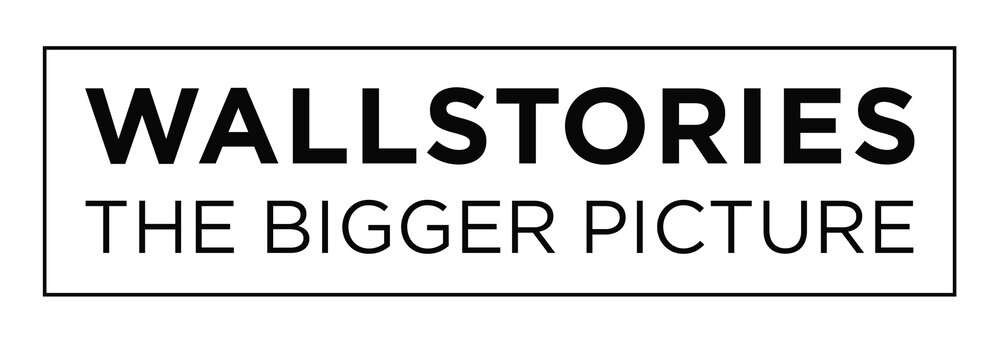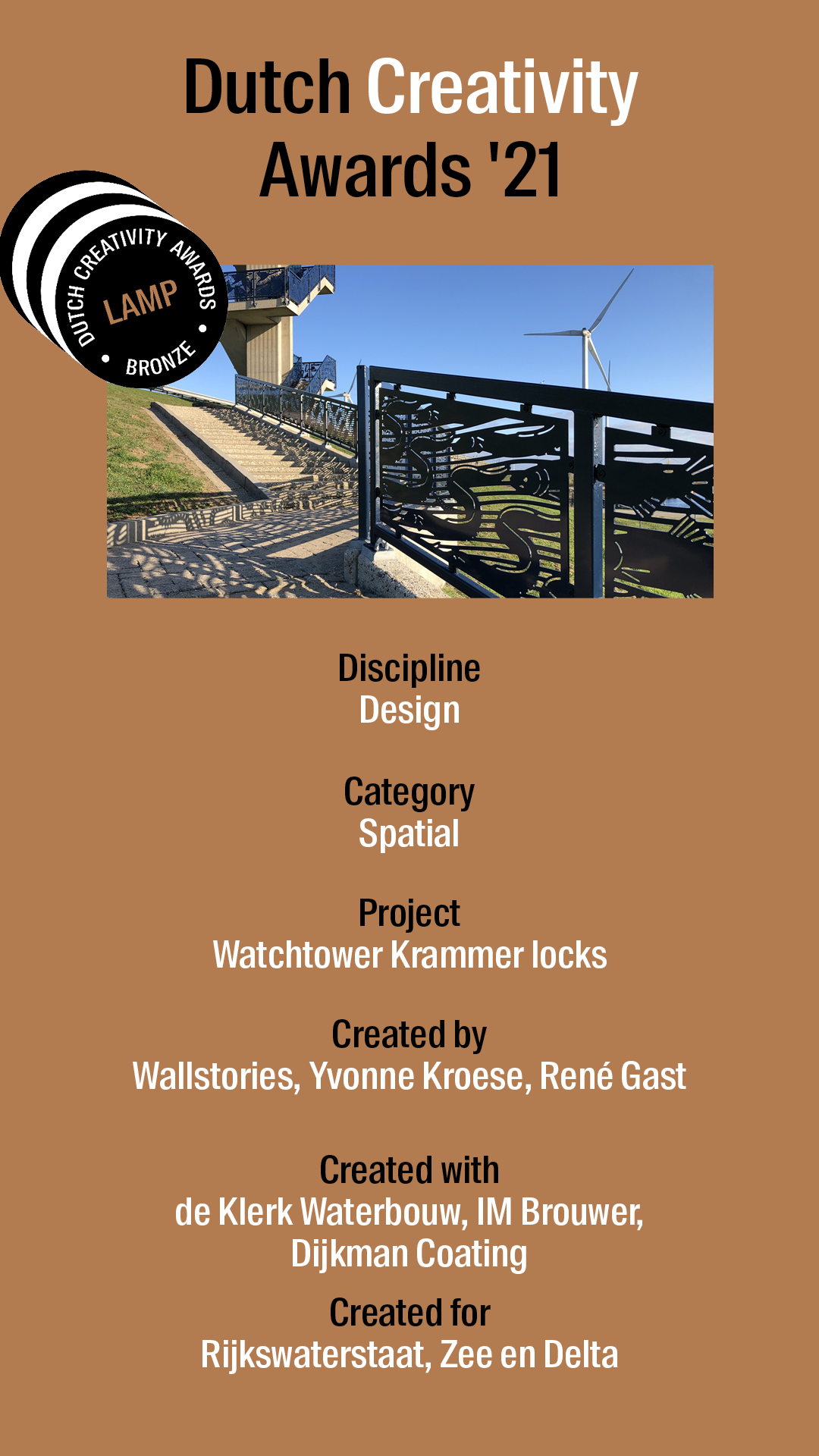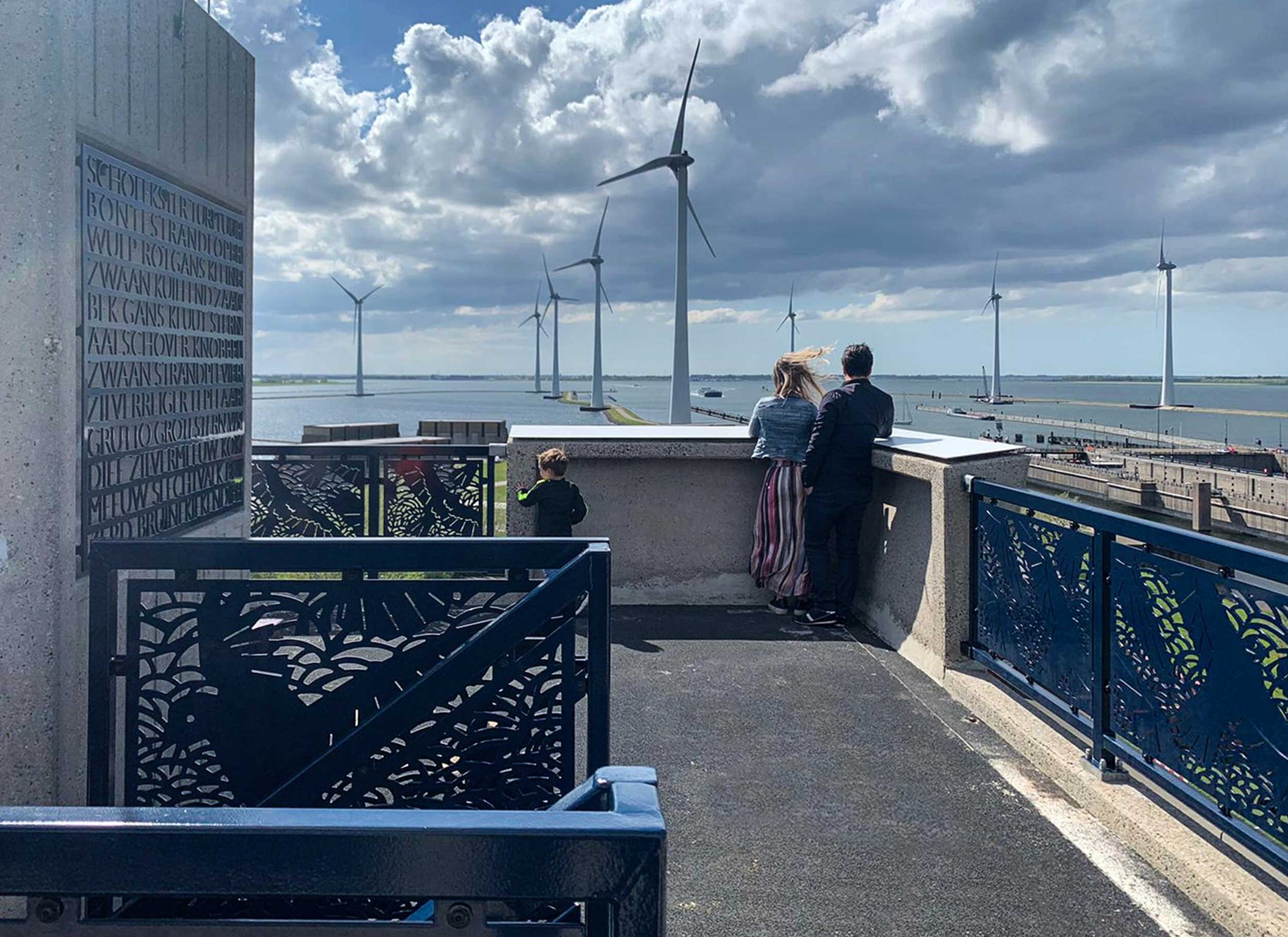WATCHTOWER
A new look for the RWS watchtower
The watchtower at the Krammer locks in Zeeland has undergone a metamorphosis. The 132 panels that form a fence around the tower depict the diversity of the animal life in this area where fresh and salt water merge. The panels wind up the tower from its base up to the top deck. Kijk hier voor de Nederlandse versie van dit project (Dutch version).
Jury feedback: “A small intervention can make a massive difference. The intervention is beautifully executed and brings the tower as a whole in a completely new light.”
The area around the tower
The watchtower is situated next to the locks on the Philipsdam, at the centre of the Krammer Wind Farm. Link to short movie and article in online magazine Rijkswaterstaat
Renovation of the lock complex
RWS is renovating the Krammer locks on the Philipsdam, which were built 40 years ago as part of the Delta Plan. This lock complex is an imposing multi-functional building structure in Zeeland. The locks work as a defence at high water, separate fresh from salt water, allow freight ship passage and enable fish migration. The tower offers a view of all this activity and the rich bird life in the area.
The tower
The tower - built in the 1980’s - is a robust concrete building structure with metal fencing that climbs angularly to reach its wider platform at the top. Below are the original construction drawings from 1986.
The 33 metre high platform offers a phenomenal view of the area and its abundant plant and animal life, from seals to birds of prey.
Old and new panels
The tower had fallen into disrepair, the tough weather conditions in this area had reduced the once shiny blue-black fencing into dull, grey panels. Here was work to be done. The idea was that the weathered trespa panels should be the first to go. Why not let the panels tell us about the surroundings?
Left the old situation, right the new panels
Ecology as theme
Our challenge was to come up with a design that took into consideration both the architecture of the tower and its surroundings. A solution which would give the tower a less solid and more contemporary appearance. RWS agreed to go along with our plan and so began our inspiring design collaboration. Our chosen theme was ecology: exhibiting the beauty of the diversity of the animal world. The tower now functions as a three dimensional icon for the exceptional flora and fauna in this area where fresh water meets the sea and is a permanent reminder of the importance of the preservation of our vulnerable landscape.
Water Earth Air
We chose a continual upward motion for the steps and the tower: from the water via the earth to the air. A ribbon that winds its way from the base of the tower up to the top deck. From seaweed to fish, crustaceans and shellfish, from wading birds and water fowl to birds of prey. A continuing sequence of images, both illustrative and educational. On his way to the top the visitor follows the fish and birds on the slowly changing panels. It has not become a full-scale encyclopedia but is a representation of the diversity of the animal life.
Form
We chose a clear and compact design and a flow of images which fit in well with the character and the austere form of the long staircase and the tower itself. We retained the original blue-black colour of the panels and railings because of the contrast with the, usually lighter, sky to keep the image sharp and compact. The density of the design was decided by the necessary safety rules but it has remained light, open and clear.
Artwork continuing sequences
There are two typographical panels on the top deck with the names of the fish and birds incorporated in the panels. Finding out which animal is where is an interesting exercise for visitors as they make their descent!
Material
Public artworks have to conform to a whole package of requirements such as safety, being vandal and weatherproof, maintenance friendly, sustainable, weight, strength, etc. The water cut panels are made of high quality, seaworthy aluminium and are 6mm thick. They have been treated with a special procedure. The fixtures of the panels to the railings were specially made to go with the design: slender, slim and strong.
Specially designed fittings were added to the panels to attach them to the frames of the railing. The anti-theft nuts and bolts are treated with charcoal grey powder coating. (photographed from the outer side)
Work method
We always begin with thorough research, we become acquainted with the area, study its history and consider any plans for the future. The dam and the Krammer locks are part of the main three Delta works - alongside the Oosterschelderkering and the Maeslantkering. 90,000 ships pass through these locks each year, creating an important passage between both Germany and Belgium. The tower is built at the point where fresh and salt water meet and natural areas of beauty have arisen on both sides of the dam. These show the contrast between the fresh and salt water landscapes and the enormous diversity of fish and animal life. The area provides many opportunities for visual storytelling.
The construction of the Delta works’ fourth dam, the Grevelingendam, between Schouwen-Duivenland and Goeree-Overvlakkee in 1958. The dam was partially constructed by means of cable cars, from which stones were dropped from above in order to form the dam. The Philipsdam, where the tower and the locks are situated, connects to the Grevelingendam. Unlike the Grevelingendam, the Philipsdam was built with sand, something which had never been done before in such deep water.
Sketches and alternative ideas
We researched and experimented with different themes and subjects for the visual story incorporated on the tower. The disastrous flooding in 1953, the clever engineering of the Delta works, nature, ecology and farming, the shipping trade, the connection to the Oosterscheldekering, fresh versus salt water, the mussel fishing industry... Ecology and biodiversity were eventually the subjects that had the most appeal - subjects that are important to us all.
The following images show some of the alternative themes and techniques we considered.
Material research: Untreated duplex stainless steel or aluminium with dark blue powder coating. The advantage of stainless steel is that no further treatment is necessary but on the other hand the images are more pronounced against the often lighter skies when a dark colour is used.
The use of photography was one option. In order to illustrate the Delta works or, as in this example the flooding in 1953. This technique works in the same way as the raster used in newspaper printing. The photographic image is translated into dots which become perforations in the aluminium. The image is abstract when seen close up and becomes recognisable when seen from a distance. The panels around the tower were just a bit too small to visualise the story in this way.
Another option was the use of text in the form of a poem or a string of words winding its way around the tower. In this case too the words would be legible from a distance and become an abstract pattern close up. This creates a strong visual effect as you walk past, emphasising the sense of depth. Thicker aluminium or horizontal supports across the vertical design to make the panel strong enough would have been necessary for this option.
A typographical variation in which each panel would contain one letter in order to incorporate the often unusual bird names.
We also considered the possibility of using animal life as illustrations using the same technique as with the typography. This also emphasises the depth but once again horizontal supports would be necessary which would not be compatible with the design.
Dazzle painting as camouflage was used during the First World War. It consisted of painting ships with complex patterns of geometric shapes in contrasting colours, interrupting and intersecting each other. The intention was to mislead the enemy about a ship’s course and make it difficult to estimate a target’s range, speed and direction. We considered using this technique in order to turn the tower into a real landmark. We rejected this idea as coastal conditions, exposure to sun and salt winds, would cause quick deterioration of the cement paint.
‘Making-of’ photos taken during the installation process. Our clients from Rijkswaterstaat Sea and Delta, contractor de Klerk’s team and IM Brouwer’s assembly experts.
Wind farm
Until recently the 33 metre tower was by far the highest building in the area. In the past few years it has become surrounded by 34 giants, each 122 metres tall, in the form of enormous wind turbines with 57 metre rotating blades. From a distance our ‘little tower’ is engulfed by this grotesque landscape but once you are near or have climbed to the top you delude yourself of its height and enjoy an amazing view of the surrounding area.
Images from the control tower at the Krammer locks wind farm and a report from the television programme “Vroege Vogels” (Early Birds)
The turbine stops on detection of a bird of prey
It’s quite a feat: positioning 34 enormous wind turbines in a fragile landscape like Krammer-Volkerak. The territory is a paradise for birds and other animal life. The Delta works have separated this eastern area from the sea and turned it into a small fresh water lake. Birds breed on the small islands and sandbanks. They also migrate from Krammer-Volkerak. Even so, Provincie Zeeland designated the area as a new location for a wind farm. Partly because of the relatively few people living in the area.
The wind turbines are fitted with technology that is able to temporarily shut them down if birds or bats are detected and so prevent them being hit by the deadly blades. The end of a turbine blade is deliberately positioned is 60 metres above ground level. Most birds fly at a height of 20 to 35 metres and will therefore fly underneath the blades. This warning system was devised for large birds of prey, such as the bald or white tailed eagle, that fly higher, concentrating on looking down, and paying less attention to what might be in their way.
Link to item Vroege Vogels Link to video item Omroep Zeeland
Location
The Philipsdam is part of the Delta works and creates the barrier between the salt water of the Oosterschelde and the fresh water Volkerakzoom lake. The roughly 7 kilometre long dam stretches from the Grevelingendam to St. Philipsland (N257). The Krammer locks are part of the Philipsdam.
The construction of the Oosterscheldekering reduced the tide levels. Tidal activity is however necessary for the flora and fauna and the important cultivation of mussels. The Philipsdam and the Oesterdam were constructed in order to restore the situation. The territory around the Krammer locks has been recognised as a Natura 2000 spot. A European network of protected nature reserves, Natura 2000 ensures that certain animals and plants and their natural habitats are protected in order to preserve biodiversity.
Fresh and salt water division
Renovation brings innovation: the new fresh-salt water division system provides (air)bubble screens and rinses the fresh water. Ships have less waiting time, need less maintenance and use less energy.
Video Rijkswaterstaat about the renovated lock complex.
DELTA ROUTE. The ANWB and Rijkswaterstaat have produced a map showing the 13 Delta works. Learn about past, present and future water safety.
CREDITS
Client: Rijkswaterstaat, Zee en Delta, Hoofdvaarwegennet team B, Renovatie Krammersluizen - Contractor: de Klerk Waterbouw - Water cutting and assembly: IM Brouwer - Powder coating: Dijkman Coating - Concept, design and artwork: Wallstories












































